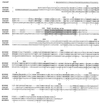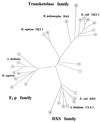Identification of a thiamin-dependent synthase in Escherichia coli required for the formation of the 1-deoxy-D-xylulose 5-phosphate precursor to isoprenoids, thiamin, and pyridoxol
- PMID: 9371765
- PMCID: PMC24228
- DOI: 10.1073/pnas.94.24.12857
Identification of a thiamin-dependent synthase in Escherichia coli required for the formation of the 1-deoxy-D-xylulose 5-phosphate precursor to isoprenoids, thiamin, and pyridoxol
Abstract
In Escherichia coli, 1-deoxy-D-xylulose (or its 5-phosphate, DXP) is the biosynthetic precursor to isopentenyl diphosphate [Broers, S. T. J. (1994) Dissertation (Eidgenössische Technische Hochschule, Zürich)], thiamin, and pyridoxol [Himmeldirk, K., Kennedy, I. A., Hill, R. E., Sayer, B. G. & Spenser, I. D. (1996) Chem. Commun. 1187-1188]. Here we show that an open reading frame at 9 min on the chromosomal map of E. coli encodes an enzyme (deoxyxylulose-5-phosphate synthase, DXP synthase) that catalyzes a thiamin diphosphate-dependent acyloin condensation reaction between C atoms 2 and 3 of pyruvate and glyceraldehyde 3-phosphate to yield DXP. We have cloned and overexpressed the gene (dxs), and the enzyme was purified 17-fold to a specific activity of 0.85 unit/mg of protein. The reaction catalyzed by DXP synthase yielded exclusively DXP, which was characterized by 1H and 31P NMR spectroscopy. Although DXP synthase of E. coli shows sequence similarity to both transketolases and the E1 subunit of pyruvate dehydrogenase, it is a member of a distinct protein family, and putative DXP synthase sequences appear to be widespread in bacteria and plant chloroplasts.
Figures





References
-
- Coolbear T, Threlfall D R. In: Biosynthesis of Terpenoid Lipids. Ratledge C, Wilkinson S G, editors. New York: Academic; 1989. pp. 115–254.
-
- Bach T J. Lipids. 1995;30:191–202. - PubMed
-
- Banthorpe D V, Charlwood B V, Francis M J O. Chem Rev. 1972;72:115–155. - PubMed
-
- Beyia E D, Porter J W. Annu Rev Biochem. 1976;45:113–142. - PubMed
Publication types
MeSH terms
Substances
Grants and funding
LinkOut - more resources
Full Text Sources
Other Literature Sources
Molecular Biology Databases

